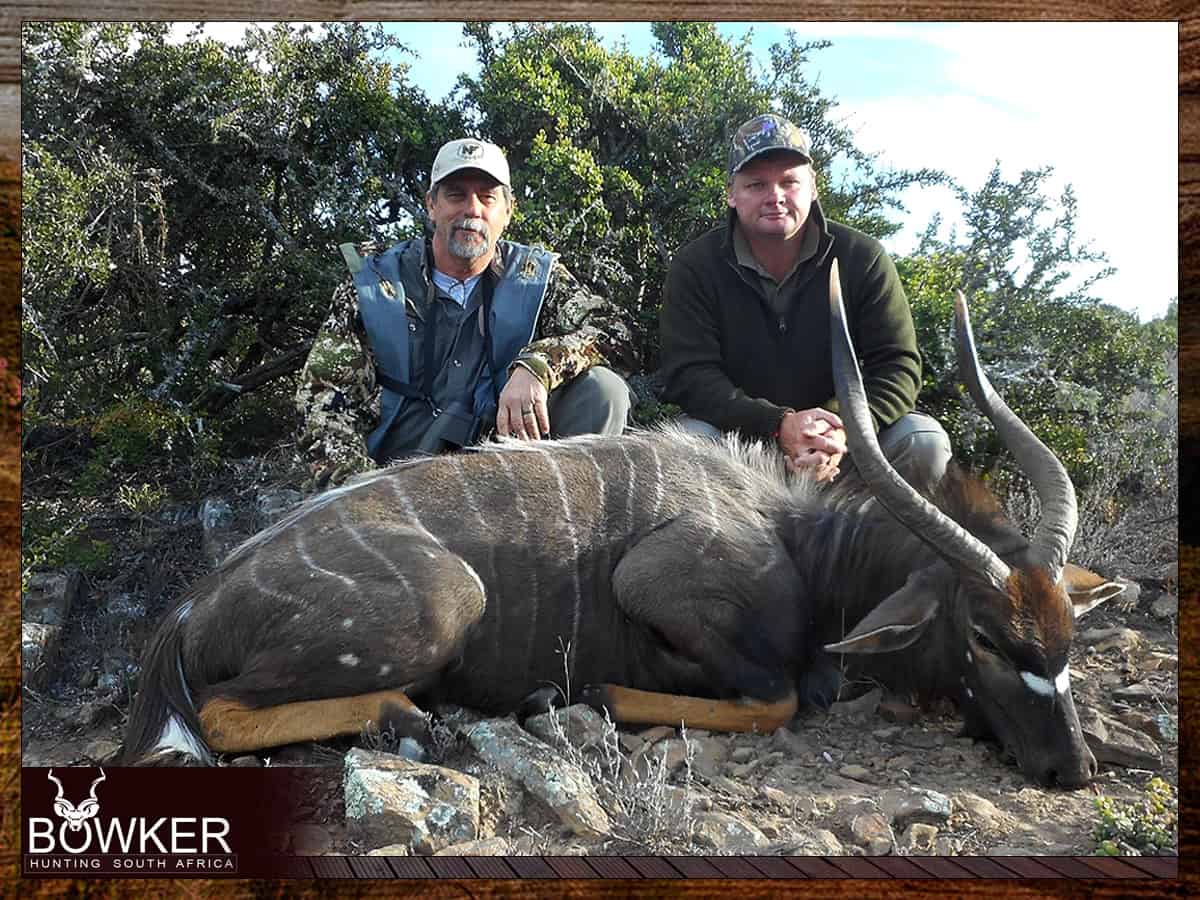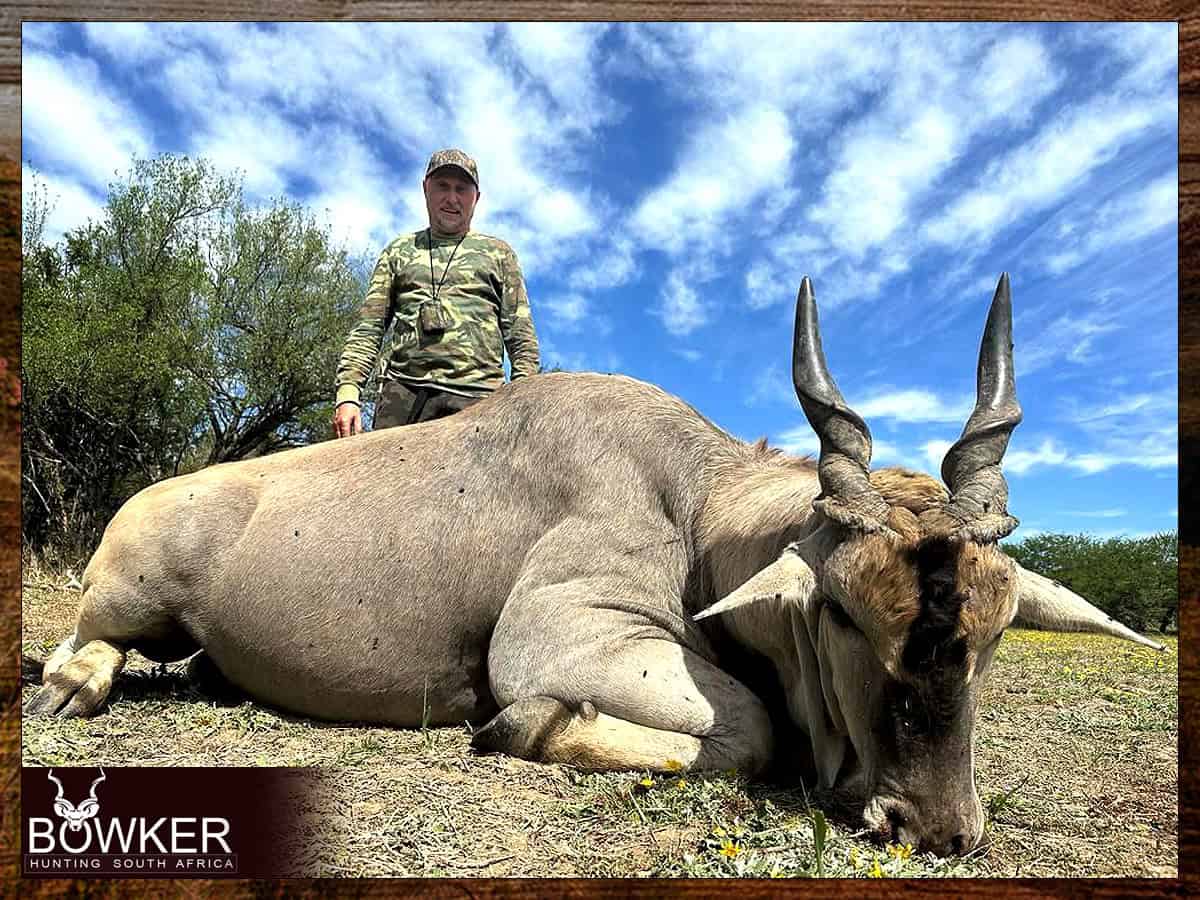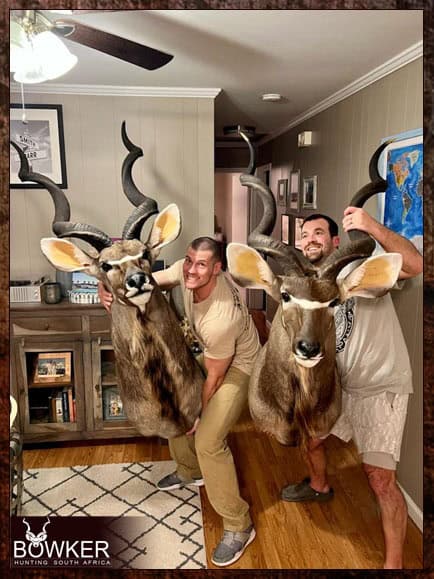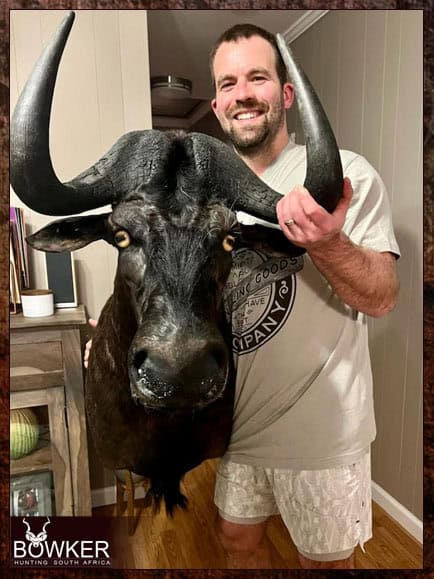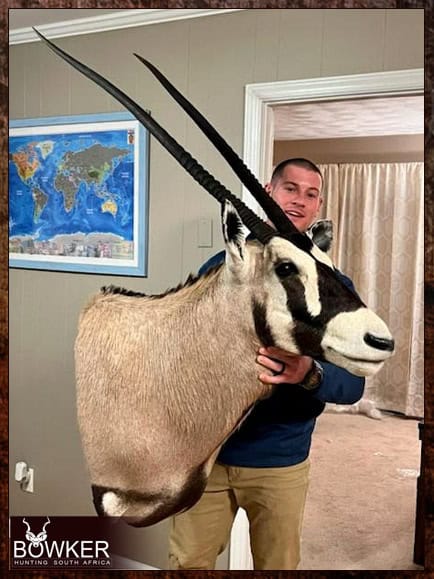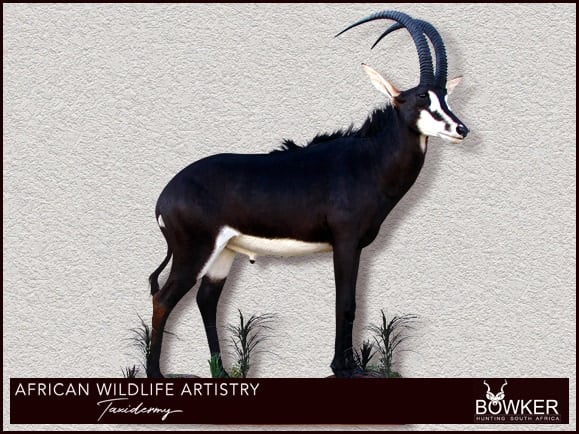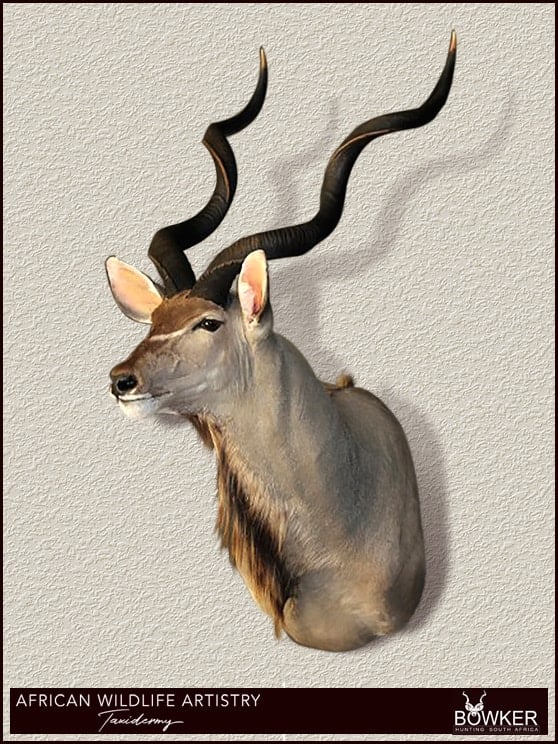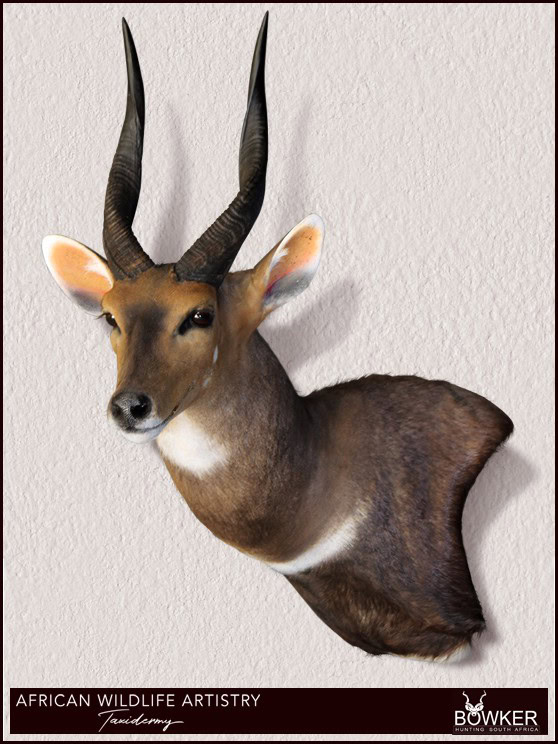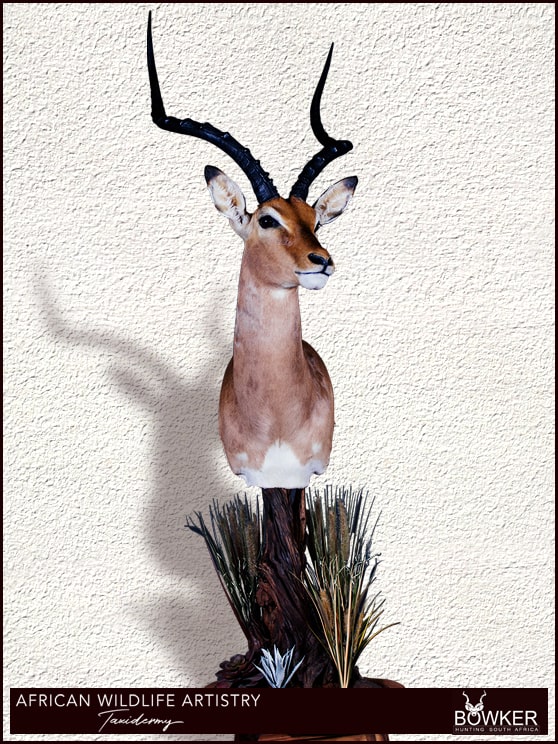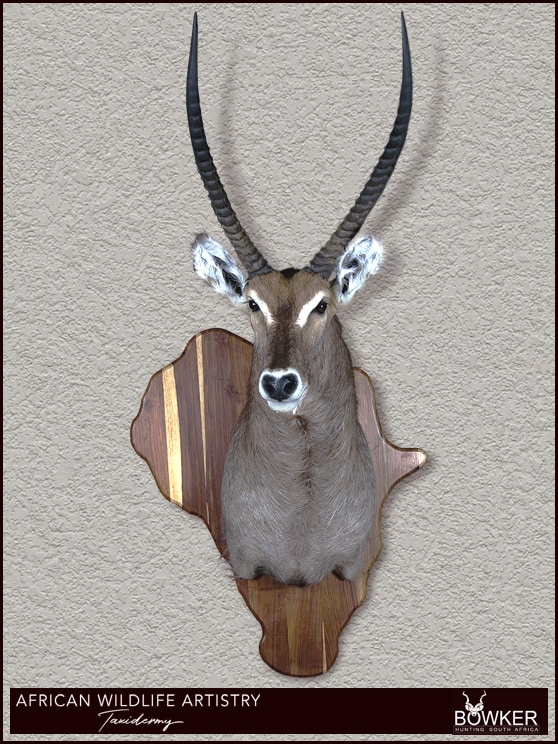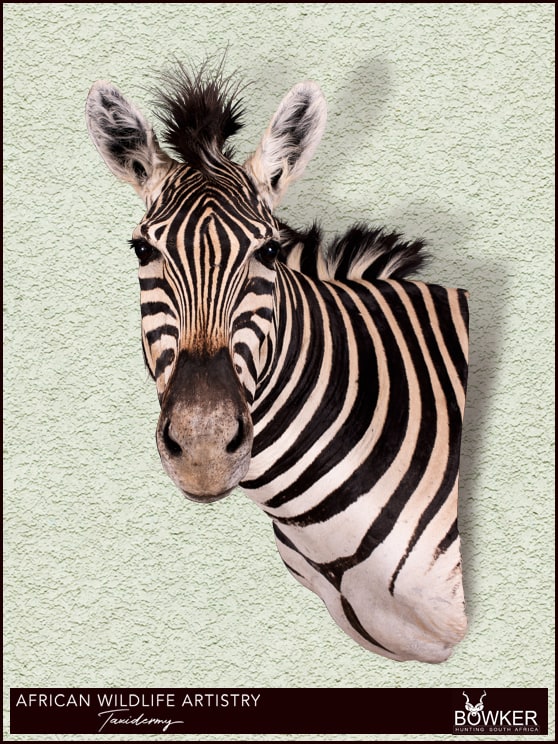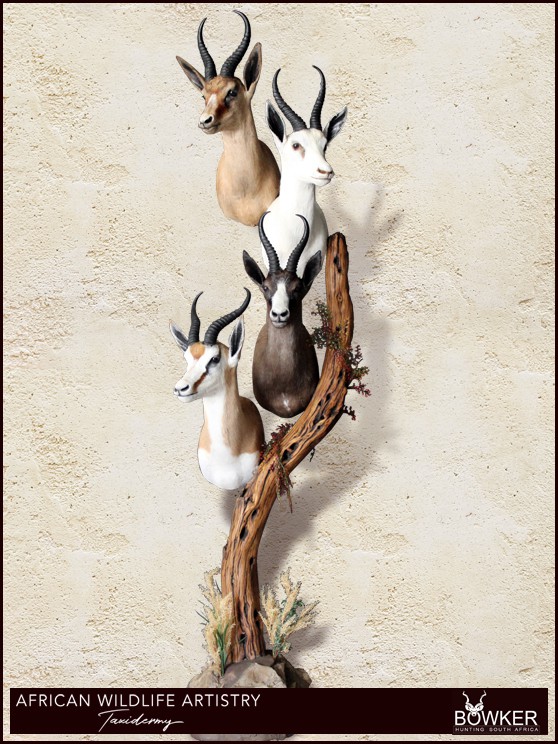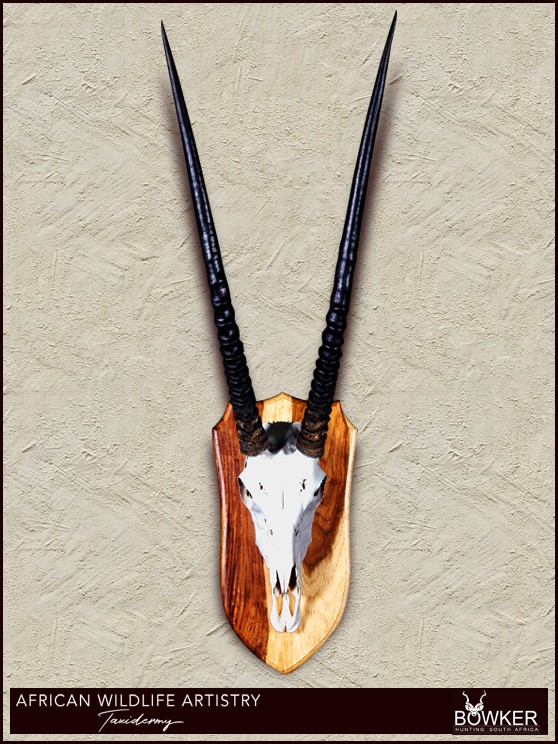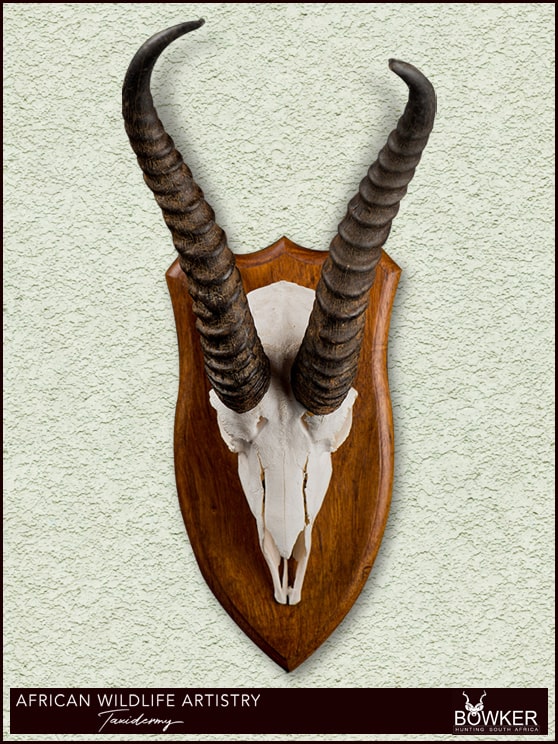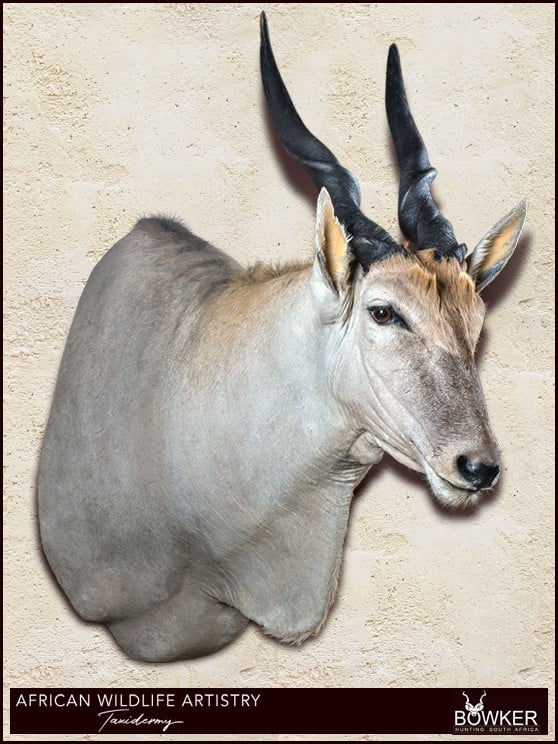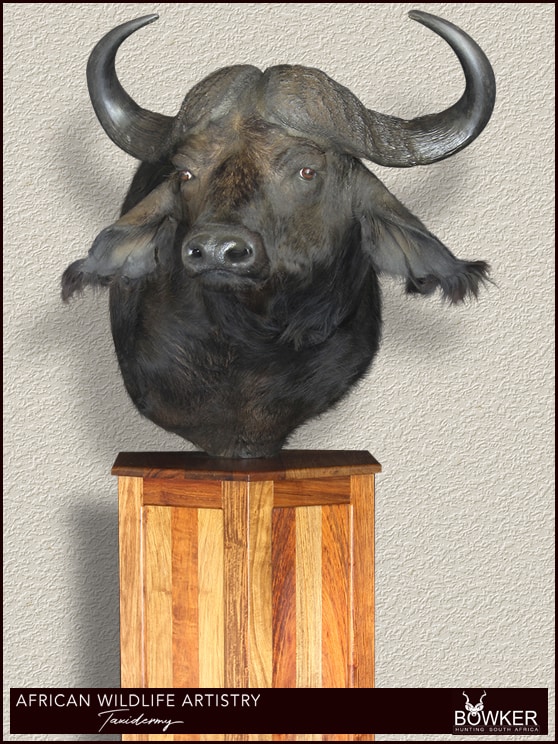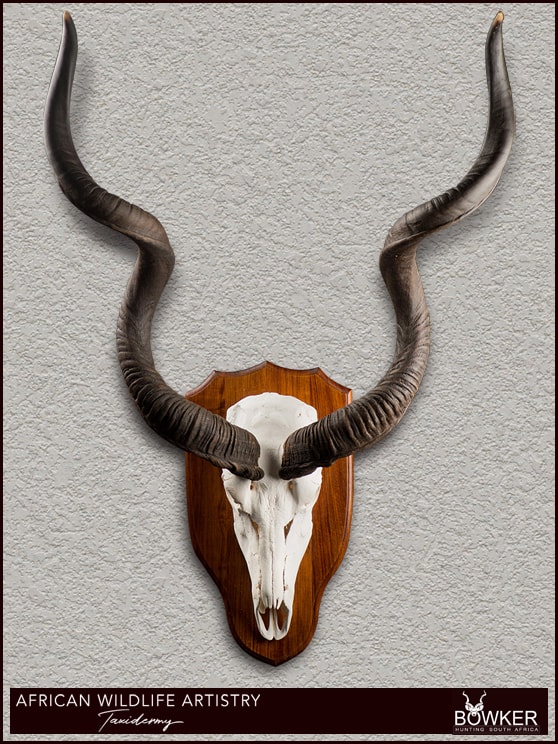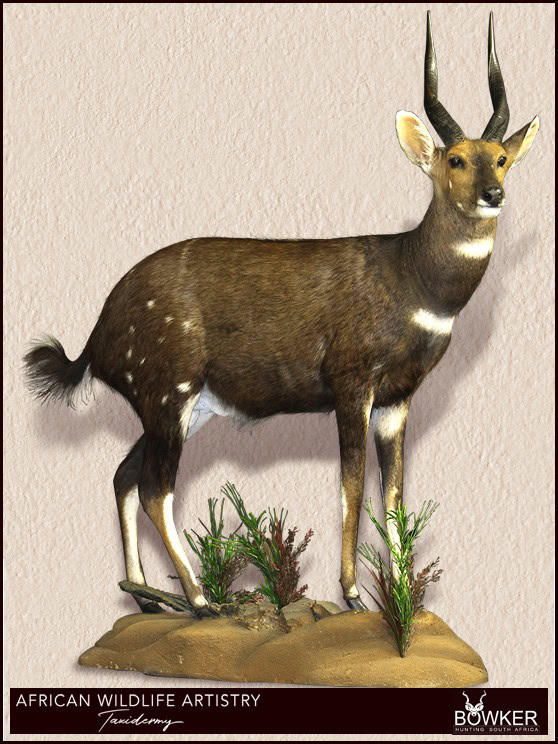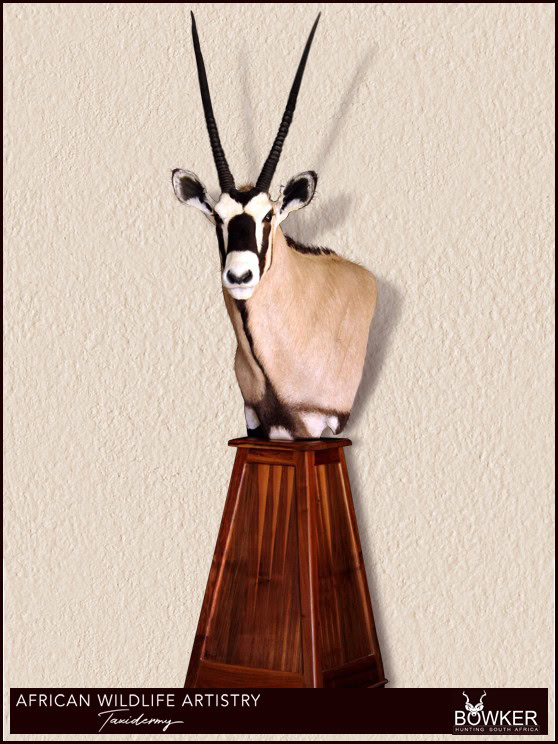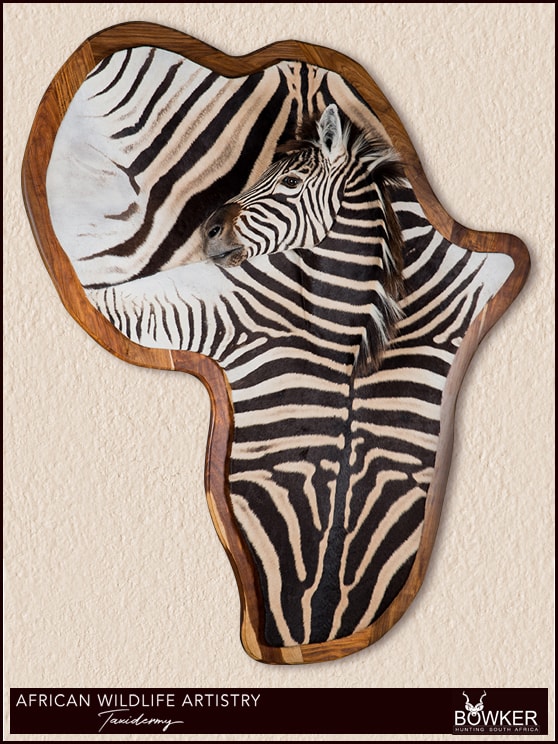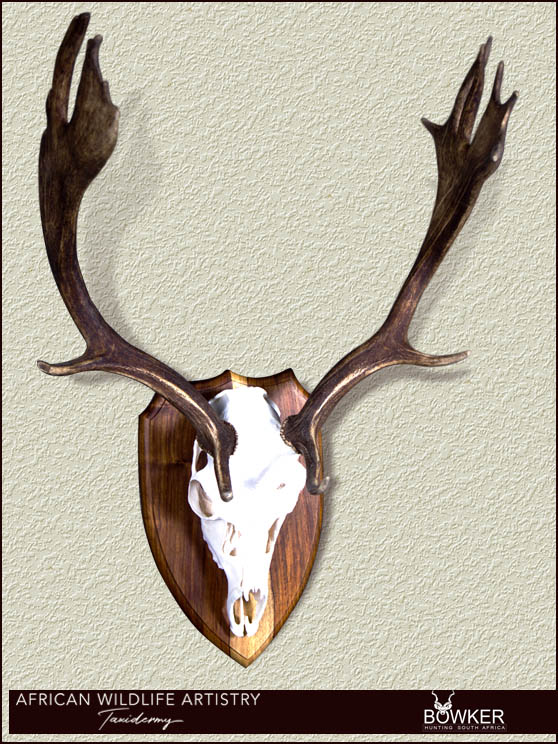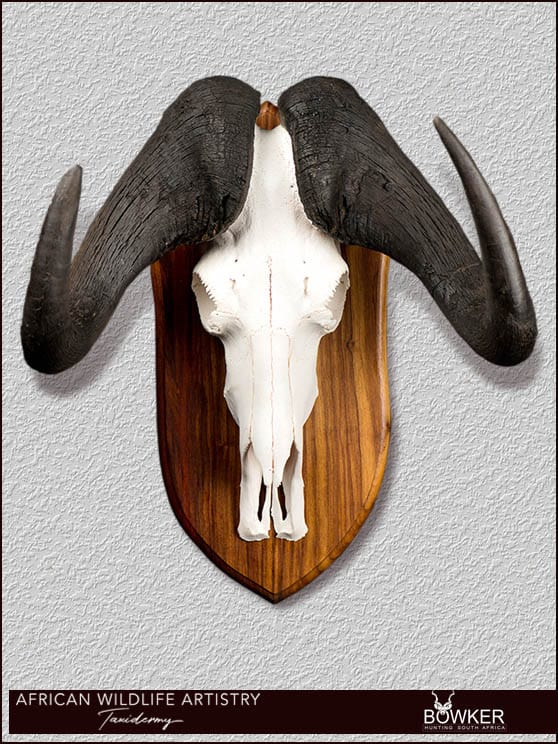Table of Contents
Introduction to African taxidermy
Long after your African safari has concluded, the shoulder mounts and rugs displayed in your office or trophy room will continue to remind you of your adventure.
These trophies are not just souvenirs but are the most enduring and significant mementos of your African hunting experience. Taxidermy also represents a substantial part of the overall safari cost, so it’s important to plan how you wish to display your trophies even before you leave home.
Space and budget limitations are common considerations. Based on the species you intend to hunt, you should think about where and how you want to display your trophies. Plan where you might hang a traditional shoulder mount, including the direction it should face. Also, consider alternative display options such as floor or wall pedestals.
Certain species, like the sable antelope, are particularly suited to wall pedestal mounts, while others, such as the Red Lechwe, look impressive when their front legs are showcased. Some species may be grouped together effectively in a cluster mount.
If you opt for European (or skull) mounts, consider using the hides or back skins as secondary trophies to create stunning rugs. These thoughtful considerations will help ensure that your trophies are displayed in a way that honors your memories and fits your home’s aesthetic.
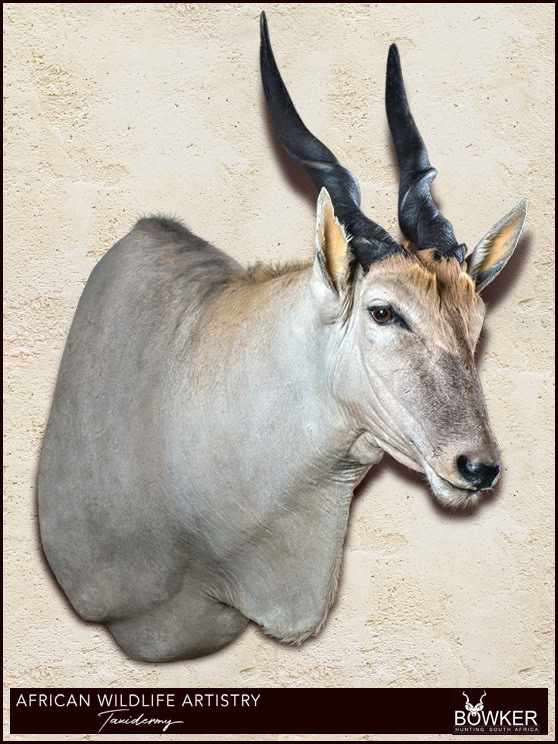
Why do your taxidermy in South Africa?
Taxidermy of African trophies is often better conducted in Africa rather than in the USA for several reasons, ranging from the expertise of local taxidermists in handling indigenous species to cost-effectiveness and logistical advantages. Here’s a comprehensive brief on why it’s beneficial to have African Wildlife taxidermy done in Africa:
Expertise and Authenticity
- Local Knowledge: African taxidermists have extensive experience and understanding of the local wildlife. This expertise allows them to achieve more accurate and lifelike representations, capturing the essence of the species with greater authenticity.
- Specialization: Taxidermists in Africa are often specialized in the native species and are familiar with the nuances of their anatomy and natural poses, which might not be as well-understood by taxidermists outside the continent.
Quality of Materials and Methods
- Freshness of Specimens: Taxidermy done immediately after the hunt ensures that the quality of the skins and other materials is preserved. The shorter the time between the hunt and the taxidermy process, the better the quality of the final mount.
- Advanced Techniques: Many African taxidermists use advanced tanning chemicals and methods, such as those from renowned German chemical manufacturers, ensuring high-quality preservation that meets international standards.
Cost-Effectiveness
- Lower Costs: The cost of taxidermy services in Africa is generally lower due to the lower cost of labor. Additionally, by avoiding the need to ship raw trophies internationally for mounting, you save significantly on shipping costs.
- Integrated Services: Many African taxidermy firms offer package deals including skinning, tanning, mounting, and packing, which can be more cost-effective compared to paying for these services separately abroad.
Logistical Simplicity
- Simpler Logistics: Handling the entire taxidermy process in Africa simplifies the logistics of exporting the final product. Completed mounts are easier and often cheaper to transport internationally than raw, untreated trophies, which require careful handling to meet biosecurity regulations.
- Regulatory Compliance: African taxidermists are well-versed in the local and international wildlife trade regulations, including CITES, ensuring that all documentation and permits are correctly handled.
Reduced Risk of Damage
- Immediate Processing: Processing trophies on-site reduces the risk associated with transporting raw, unprocessed specimens. Immediate action prevents decay and damage that could occur during lengthy transport.
- Professional Packing: African taxidermists are skilled in packing finished trophies in a way that minimizes the risk of damage during the long journey to the USA.
Faster Turnaround
- Efficiency: Completing the African plains game taxidermy in Africa can lead to a faster turnaround for hunters eager to receive their trophies. The streamlined process from hunting to mounting can significantly reduce the waiting period.
Cultural Integrity
- Support Local Economies: By employing local taxidermists, hunters also contribute to the local economy, supporting traditional crafts and practices.
- Cultural Appreciation: The art of taxidermy in Africa is not just a service but also a form of cultural expression that deserves recognition and patronage.
Conclusion
Opting for African safari taxidermy offers a combination of authenticity, cost-effectiveness, and logistical advantages. It ensures that trophies are handled expertly and efficiently, capturing the true spirit of the African safari experience while supporting local expertise and minimizing the environmental impact associated with transportation.
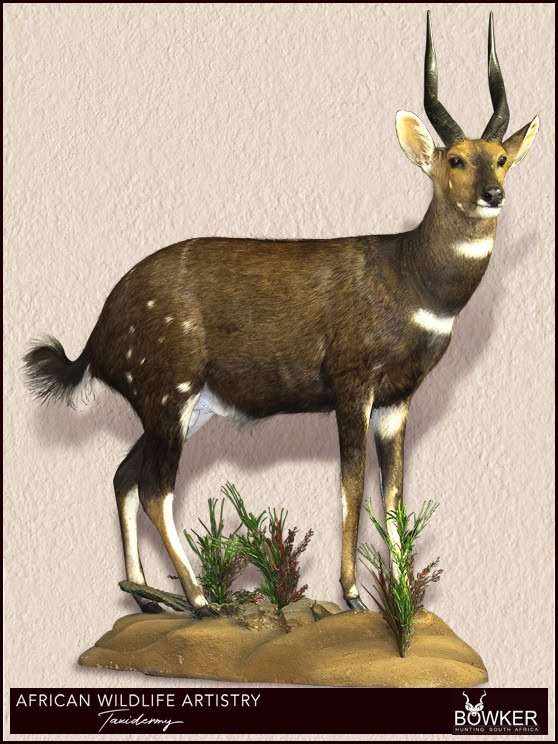
What to look for once you have shot your trophy
Proper handling of your trophy in the field is crucial to preserving its quality, especially immediately after the animal has been harvested.
Hair slip, a condition where the hair falls out of the skin, can occur if bacteria infiltrate the skin within the first 24 hours after the trophy is harvested.
To prevent this, it’s vital to communicate with your guide about the type of mount you desire so they can perform the appropriate skinning techniques.
For certain animals, like kudu and nyala from the spiral horn family, extra care is needed due to their delicately haired capes. It’s advisable to place a sail cloth under the animal during handling to prevent damage to the skin.
If you hunt trophies in the morning and plan to be out all day, it’s important to promptly remove the innards of the harvested animal and place it in the shade to prevent spoilage and deterioration of the skin.
Additionally, if your schedule allows, consider visiting your taxidermist. This gives you an opportunity to see their facilities, assess the quality of their work, and discuss specific requirements for your trophies. A visit can help ensure that your taxidermist meets your expectations and that your trophies are handled and preserved properly.
The taxidermy Process
Here’s a breakdown of the taxidermy process for your trophies, depending on whether you plan to send them to the USA for mounting or have them mounted in South Africa:
Dip and packing for trophies to be sent to the USA
- Preservation at the Safari Outfitter: Immediately after your trophy is skinned, it is preserved in salt at the skinning shed until the end of your safari.
- Collection by Taxidermist: Post-safari, your chosen taxidermist collects the trophies from the outfitter.
- Dip and Pack Process:
- Skulls: Are boiled to clean off any remaining tissue.
- Hides: Are treated with a chemical solution and then dried to ensure they are preserved.
- Horn Sheaths Removal: For animals like kudu and gemsbok, the horn sheaths are removed to save space and reduce shipping costs.
- Crating: Once dried, the trophies are crated for shipping.
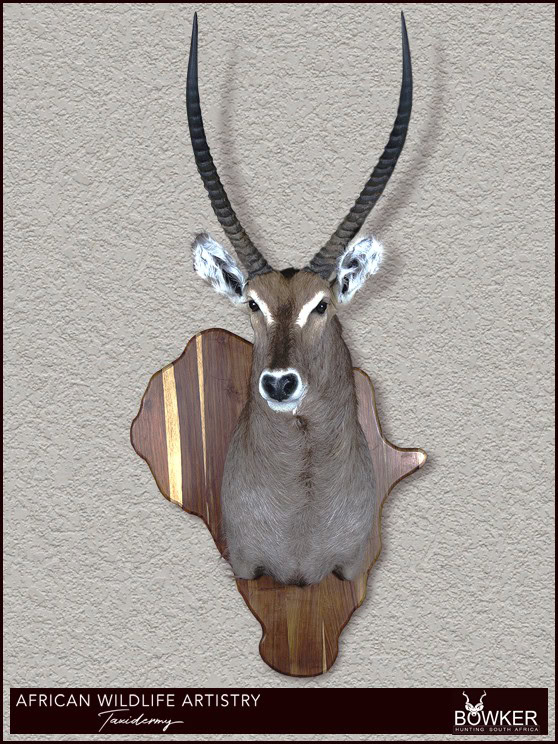
Mounting done in South Africa
- Tanning: If your trophies are being mounted in South Africa, the skins are fully tanned. During this process, any extra fat is shaved off.
- Mount Preparation:
- Skin Placement: The tanned skin is placed on a mannequin or form, shaped, and stitched together.
- Drying: The shaped skin is left to dry.
- Detailing: Fine details around the eyes and lips are carefully attended to during this phase.
- Final Touches: Once the mount is dry, final artwork and touch-ups are applied.
- Crating and Shipping: Completed mounts are then packed into crates and prepared for shipment.
General tips
- Dip and Pack: This process is essential if you plan to send your trophies back to the USA for mounting. It ensures that the trophies are preserved and meet both South African and U.S. import and export regulations.
- Mounting Locally: Opting for mounting in South Africa can be more cost-effective and allows for detailed oversight during the taxidermy process.
Understanding these steps will help you make informed decisions about handling your trophies, ensuring they are preserved correctly and arrive in the best condition for mounting.
Detailed dipping process
Dipping and packing, often known as raw preparation, solution treated, or unfinished processing, is the essential minimum treatment that hunting trophies must undergo before they can be imported into the United States. This process ensures that all parts of the trophy, such as bones, hooves, horns, skulls, teeth, and tusks, are properly prepared for entry into the country. Here’s what’s involved in the process:
- Cleaning: Each component of the trophy must be thoroughly cleaned. This means removing all undried pieces of hide, flesh, sinew, or any other organic matter that might still be attached. The goal is to ensure that there are no remnants that could decay, which is crucial for meeting health and safety standards.
- Drying: After cleaning, the parts must be completely dried. This step is vital because any moisture remaining can lead to the growth of bacteria and fungi, which can cause deterioration and odors, and potentially lead to the rejection of the import at the border due to biosecurity concerns.
- Treatment with Solutions: The cleaned and dried parts are treated with chemical solutions that help preserve them and prevent the growth of pathogens. This treatment is part of what makes the process compliant with international shipping and health regulations.
- Packing: Once the trophies are cleaned, dried, and treated, they are securely packed for shipping. Proper packing reduces the risk of damage during transit and helps ensure that the trophies arrive in the best possible condition.
This procedure is not just a regulatory formality but a crucial step in preserving the quality of your trophies while also safeguarding ecosystem health by preventing the international spread of diseases. It’s important for hunters to work with experienced and reputable taxidermists or processing agents who understand the strict requirements needed for international trophy shipments.
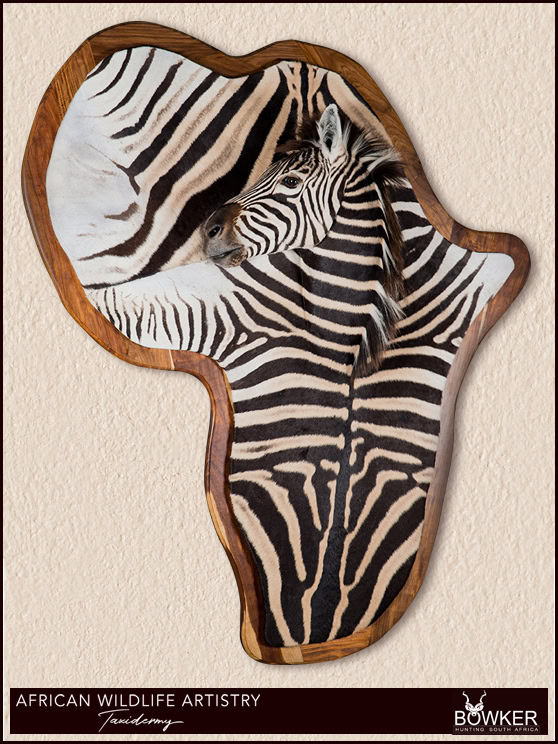
The disinfection process includes the following:
For the proper disinfection of hunting trophies, particularly the inner cores and horns, specific soaking treatments are employed to ensure thorough sterilization. Here’s a detailed breakdown of each step:
- Soaking in Boiling Water:
- Purpose: Helps to loosen and remove remaining tissue and dirt.
- Process: The inner cores and horns are submerged in boiling water. This process typically lasts for a minimum duration necessary to ensure that all organic material is loosened and can be removed easily.
- Soaking in 0.1 Percent Chlorine Bleach Solution:
- Purpose: Acts as a disinfectant to kill bacteria and viruses on the surface of the bones and horns.
- Process: Items are soaked in a 0.1 percent solution of chlorine bleach for a set period, which helps to sanitize and whiten the material, making it safe and clean.
- Soaking in 5 Percent Formaldehyde Solution:
- Purpose: Used for its preservative and disinfectant qualities.
- Process: Soaking the horns in a 5 percent formaldehyde solution effectively sterilizes them, preventing decay and contamination. This step is crucial, especially if there is a risk of transmitting diseases.
- Soaking in 5 Percent Hydrogen Peroxide:
- Purpose: Aids in bleaching and further disinfecting the material.
- Process: The inner cores are submerged in a 5 percent hydrogen peroxide solution for a minimum period to ensure thorough disinfection and to help in whitening the trophies, giving them a clean, preserved look.
Each of these steps plays a vital role in preparing the trophies for safe international transport and display, adhering to both health and aesthetic standards. It’s essential to follow these procedures carefully and allow sufficient time for each soaking period to ensure effective disinfection.

General information for dipping and Tanning
Here’s a breakdown of important steps and considerations when preparing and shipping untanned hides and other trophies:
- Drying Untanned Hides:
- Hides must be thoroughly dried to the point where they appear brittle and could crack when bent. This level of dryness ensures that the hides are less susceptible to decay and pest infestation during storage and transport.
- Packing After Treatment:
- After the necessary treatments and drying, trophies should be packed immediately. It’s crucial to avoid contact with any animal products that could potentially reintroduce contaminants such as bacteria or insects.
- Cleanliness of Trophies:
- Professionally cleaned trophies should be free from dirt, blood, insects, and any putrid odors. This not only complies with biosecurity standards but also maintains the quality and integrity of the trophies during transport.
- Shipping Requirements for the USA:
- When exporting to the United States, dipped and packed trophies must be consigned to a USDA-approved establishment. This could be an approved tannery or taxidermist and not directly to the client. This requirement is in place to ensure that all imported animal products meet stringent health and safety regulations before they enter the country.
- Effectiveness of Insecticides:
- Hunters should be aware that insecticides used on hides have a limited shelf life and may lose their effectiveness over time. If the effectiveness diminishes, it could lead to damage to the hides due to pest activity. Regular checks and possibly re-application of the protective treatments may be necessary to maintain the preservation of the hides.
Following these guidelines helps ensure that the trophies remain in excellent condition throughout the process and comply with all regulatory requirements for international shipping, particularly into the United States.
Tanning also referred to as cape tanning or dry tanning
The process of tanning in South Africa has evolved significantly, offering hunters several benefits, especially in terms of quality and logistics:
- Quality of Tanning:
- Many taxidermists in South Africa now use high-quality original BASF (German) chemicals for tanning. This ensures that the tanned hides are of superior quality, which is crucial for the durability and appearance of the final mounted trophies.
- Damage Control:
- Any damages to the trophies can be identified and rectified in South Africa before they are exported. In severe cases, parts like hides or skulls can even be replaced. This proactive approach minimizes the risk of you receiving unsatisfactory trophies and the need for further costly repairs or replacements after they have been shipped.
- Reducing Shipping Costs:
- Opting for tanning and preparing the hides and skulls for mounting in South Africa, rather than just dipping and packing, can be more space and weight-efficient. Finished tanned hides and fully bleached and cut skulls take up less space and weigh less compared to dipped and packed cargo. This reduction in volume and weight translates directly into lower export and import costs.
- Efficiency in Receiving Your Trophies:
- By starting the tanning process in Africa during the months it takes to prepare for export, you effectively use this waiting period to advance the preparation of your trophies. This means that once the hides and skulls reach your local taxidermist, much of the preliminary work has already been done. As a result, the turnaround time for final mounting is shorter, allowing you to receive your finished trophies much sooner.
This approach not only enhances the efficiency of the process but also ensures that the quality of the work meets international standards, making it a worthwhile consideration for hunters looking to bring home trophies from Africa.
Selecting your shipping agent
When choosing a shipping agent for your trophies, it’s essential to consider several factors:
- Taxidermist Recommendations: Many taxidermists handle their own packaging and typically charge around 10 percent of the total taxidermy cost for this service. They often have preferred shipping companies they work with regularly and can recommend.
- Independent Quotes: Before finalizing the shipping arrangements, it’s advisable to get quotes from independent shipping agents. This allows you to compare costs and services, ensuring you get the best deal possible.
- Shipping Process in South Africa:
- Crate Transfer: Once you’ve selected a shipping agent, they will move the crates from the taxidermist to their warehouse, initiating the export process.
- Permit Handling: The taxidermist should have already applied for all necessary permits required for the export of the trophies.
- Inspections: If required, inspections by government conservation authorities are carried out at the shipping company’s warehouse.
- Loading and Shipping: After ensuring all documents are in order, the crates are loaded onto an airplane or into a shipping container. They are then shipped to the designated entry port in the United States.
Crating
Proper crating is critical to ensure the safe transport of your trophies:
- Secure Mounting: Trophies must be securely mounted inside the crate to prevent any movement during transit that could lead to damage.
- Handling Horns: Removable horns, such as those of kudu and gemsbok, should be detached to conserve space and wrapped securely to avoid movement within the crate.
- Minimizing Space: The arrangement inside the crate should minimize any unused space to prevent the contents from shifting.
- Material Selection: The choice of wood is crucial; it must be sturdy enough to protect the contents from external impacts and comply with international shipping standards.
- Structural Integrity: The crate’s base must be robust, with a solid footer to support the weight and allow safe handling by forklifts.
Investing in high-quality crating is an essential step to ensure that your trophies arrive in excellent condition, minimizing the risk of damage during transport. This careful preparation helps safeguard your valuable souvenirs, ensuring they last as enduring reminders of your hunting experience.
